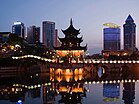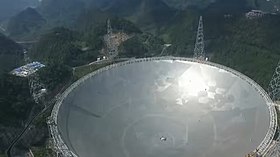
Guizhou
Province of southwestern China / From Wikipedia, the free encyclopedia
Dear Wikiwand AI, let's keep it short by simply answering these key questions:
Can you list the top facts and stats about Guizhou?
Summarize this article for a 10 year old
Guizhou /ɡweɪˈdʒoʊ/[5] (Chinese: 贵州; formerly Kweichow) is a province in the interior southwest region of the People's Republic of China. Its capital and largest city is Guiyang, in the center of the province. Guizhou borders the autonomous region of Guangxi to the south, Yunnan to the west, Sichuan to the northwest, the municipality of Chongqing to the north, and Hunan to the east. The population of Guizhou stands at 38.5 million, ranking 18th among the provinces in China.
Guizhou
贵州 | |
|---|---|
| Province of Guizhou | |
| Name transcription(s) | |
| • Chinese | 贵州省 (Guìzhōu Shěng) |
| • Abbreviation | GZ / 黔 or 贵 (pinyin: Qián or Guì) |
(clockwise from top)
| |
 Map showing the location of Guizhou Province | |
| Coordinates: 26°50′N 106°50′E | |
| Country | China |
| Named for | Gui - Gui Mountains zhou (prefecture) |
| Capital | Guiyang |
| Largest city | Zunyi |
| Divisions | 9 prefectures, 88 counties, 1539 townships |
| Government | |
| • Type | Province |
| • Body | Guizhou Provincial People's Congress |
| • CPC Secretary | Xu Lin |
| • Congress chairman | Xu Lin |
| • Governor | Li Bingjun |
| • CPPCC chairman | Zhao Yongqing |
| Area | |
| • Total | 176,167 km2 (68,018 sq mi) |
| • Rank | 16th |
| Highest elevation (Jiucaiping) | 2,900 m (9,500 ft) |
| Population (2020)[2] | |
| • Total | 38,562,148 |
| • Rank | 17th |
| • Density | 220/km2 (570/sq mi) |
| • Rank | 18th |
| Demographics | |
| • Ethnic composition | Han - 62% Miao - 12% Buyei - 8% Dong - 5% Tujia - 4% Yi - 2% Undistinguished - 2% Gelao - 2% Sui - 1% |
| • Languages and dialects | Southwestern Mandarin |
| ISO 3166 code | CN-GZ |
| GDP (2022) | CNY 1.78 trillion $ 258 billion (19th)[3] |
| - per capita | CNY 52,321 USD 7,779 (31st) |
| • growth | |
| HDI (2019) | medium · 30th |
| Website | http://www.gzgov.gov.cn (Simplified Chinese) |
| Guizhou | |||||||||||||||||||||||||||||||||
|---|---|---|---|---|---|---|---|---|---|---|---|---|---|---|---|---|---|---|---|---|---|---|---|---|---|---|---|---|---|---|---|---|---|
 "Guizhou" in Simplified (top) and Traditional (bottom) Chinese characters | |||||||||||||||||||||||||||||||||
| Chinese name | |||||||||||||||||||||||||||||||||
| Simplified Chinese | 贵州 | ||||||||||||||||||||||||||||||||
| Traditional Chinese | 貴州 | ||||||||||||||||||||||||||||||||
| Hanyu Pinyin | Guìzhōu | ||||||||||||||||||||||||||||||||
| Postal | Kweichow | ||||||||||||||||||||||||||||||||
| |||||||||||||||||||||||||||||||||
| Zhuang name | |||||||||||||||||||||||||||||||||
| Zhuang | Gveicouh 贵州 | ||||||||||||||||||||||||||||||||
| Yi name | |||||||||||||||||||||||||||||||||
| Yi | ꇭꍏ | ||||||||||||||||||||||||||||||||
The Dian Kingdom, which inhabited the present-day area of Guizhou, was annexed by the Han dynasty in 106 BC.[6] Guizhou was formally made a province in 1413 during the Ming dynasty. After the overthrow of the Qing in 1911 and following the Chinese Civil War, the Chinese Communist Party took refuge in Guizhou during the Long March between 1934 and 1935.[7] After the establishment of the People's Republic of China, Mao Zedong promoted the relocation of heavy industry into inland provinces such as Guizhou, to better protect them from potential foreign attacks.[citation needed]
Guizhou is rich in natural, cultural and environmental resources. Its natural industry includes timber and forestry, and the energy and mining industries constitute an important part of its economy. Notwithstanding, Guizhou is considered a relatively undeveloped province, with the fourth-lowest GDP per capita in China as of 2020. However, it is also one of China's fastest-growing economies.[8] The Chinese government is looking to develop Guizhou as a data hub.[9][10]
Guizhou is a mountainous province, with its higher altitudes in the west and centre. It lies at the eastern end of the Yungui Plateau. Demographically, it is one of China's most diverse provinces. Minority groups account for more than 37% of the population, including sizable populations of the Miao, Bouyei, Dong, Tujia and Yi peoples, all of whom speak languages distinct from Chinese. The main language spoken in Guizhou is Southwestern Mandarin, a variety of Mandarin.
Oops something went wrong:





